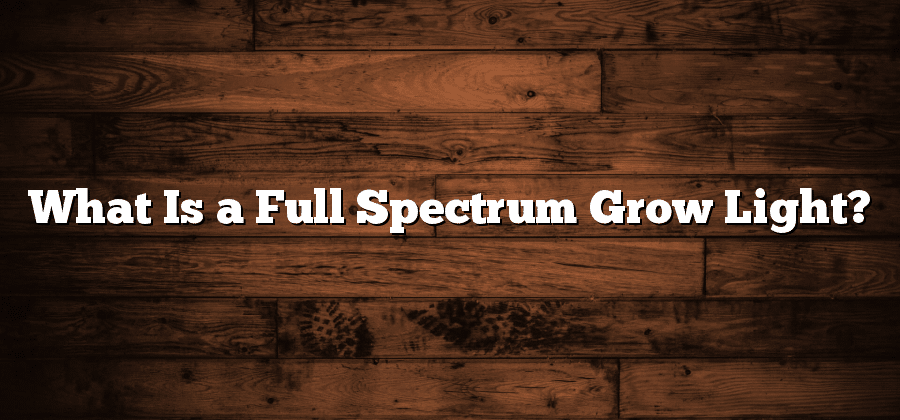Benefits of Full Spectrum Grow Lights
Full Spectrum Grow Lights offer a wide range of benefits for indoor plant growth. Firstly, these lights provide a complete spectrum of light that closely mimics natural sunlight. This means that plants receive the full range of necessary wavelengths for photosynthesis, resulting in healthier and more productive growth. Full Spectrum Grow Lights also have a higher color rendering index (CRI) compared to other types of grow lights. This means that they accurately represent the true colors of the plants, helping gardeners to assess plant health and detect any issues more easily. Additionally, these lights promote better growth and flowering in plants by providing a balance of both blue and red light, crucial for vegetative growth and flowering stages respectively.
Moreover, another significant benefit of Full Spectrum Grow Lights is their energy efficiency. These lights are designed to emit light specifically tailored to plants’ needs, minimizing wastage and maximizing growth. Unlike traditional lighting options, full spectrum grow lights do not emit excess heat, reducing the need for additional cooling systems in indoor gardens. This translates into lower energy consumption, resulting in cost savings and environmental benefits. Furthermore, the lifespan of Full Spectrum Grow Lights is significantly higher than traditional grow lights, reducing the frequency of replacement and overall maintenance costs.
Different Types of Grow Lights
When it comes to indoor gardening, choosing the right type of grow lights is crucial for the overall success of your plants. There are various options available in the market, each with its own set of benefits and limitations. One of the most popular types of grow lights is fluorescent lights. These lights are energy-efficient and provide a good balance of light for both vegetative growth and flowering stages of plants. However, they are not as intense as other options and may require closer proximity to the plants for optimal results.
Another commonly used type of grow lights is high-intensity discharge (HID) lights. HID lights, including metal halide (MH) and high-pressure sodium (HPS) lights, produce a high-intensity, full spectrum of light that closely mimics natural sunlight. These lights are especially beneficial during the flowering stage, as they promote larger buds and increased yields. However, they tend to generate more heat and require proper ventilation to prevent plant stress or damage.
Additionally, light-emitting diode (LED) grow lights have gained significant popularity in recent years. LED lights are highly energy-efficient, produce less heat, and have a longer lifespan compared to other types of grow lights. They also allow for precise control of the light spectrum, making them suitable for various stages of plant growth. However, LED lights are generally more expensive upfront, although they can provide long-term cost savings due to their efficiency and durability.
It is important to carefully evaluate the needs of your plants and your specific growing conditions before selecting the type of grow lights that best suit your indoor garden. Considering factors such as light intensity, spectrum, energy efficiency, and cost will help ensure that your plants receive the optimal light they require for healthy growth and development.
Understanding Light Spectrum in Plant Growth
The light spectrum plays a crucial role in the growth and development of plants. Different wavelengths of light have varying effects on various stages of plant growth. Understanding the light spectrum is therefore essential for optimizing plant growth and maximizing yield.
One key factor to consider is the blue light spectrum. Blue light is essential for promoting vegetative growth and the production of lush, green foliage. This is because blue light stimulates chlorophyll production, which is necessary for photosynthesis. Additionally, blue light helps regulate plant height, promoting compact growth and preventing leggy or spindly plants. This is particularly important for indoor gardening where space and light intensity may be limited.
Features of Full Spectrum Grow Lights
Full Spectrum Grow Lights are designed to replicate the natural sunlight, providing plants with the optimal light spectrum for their growth and development. One notable feature of these lights is their ability to emit a wide range of wavelengths, including blue, red, and green light. This is important because different wavelengths have different effects on plant growth and specific wavelengths are needed for certain stages of growth. By incorporating a full spectrum of light, these grow lights ensure that plants receive the necessary wavelengths throughout their entire life cycle.
Another key feature of full spectrum grow lights is their customization options. Many models come with adjustable settings, allowing growers to fine-tune the light intensity and spectrum to suit their specific plants’ needs. This flexibility is particularly beneficial in indoor gardening, where natural light may be limited or unavailable. With full spectrum grow lights, cultivators have the freedom to mimic different seasons or adjust the light spectrum based on the specific requirements of different plant species. This level of control empowers growers to optimize their plant’s growth and achieve higher yields.
How Full Spectrum Grow Lights Work
Full spectrum grow lights harness the power of different wavelengths of light to support optimal plant growth. These lights are designed to emulate natural sunlight, providing a balanced spectrum that includes all the necessary wavelengths for photosynthesis. Through the use of various light emitting diodes (LEDs), full spectrum grow lights are able to deliver light across the entire spectrum, from ultraviolet (UV) to infrared (IR). This comprehensive range of light helps plants receive all the essential energy they need to carry out photosynthesis and thrive.
One of the key features of full spectrum grow lights is their ability to provide specific wavelengths of light that cater to different stages of plant growth. For instance, during the vegetative stage, plants require blue wavelengths for promoting leaf development and root growth. On the other hand, during the flowering stage, plants benefit from red and far-red wavelengths that encourage flower and fruit production. By tailoring the light spectrum to the specific needs of plants at each growth stage, full spectrum grow lights maximize their productivity and overall health.






